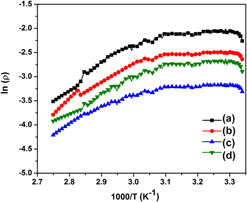Crossref Citations
This article has been cited by the following publications. This list is generated based on data provided by
Crossref.
Palanichamy, S.
Mohamed, J. Raj
Kumar, K. Deva Arun
Anitha, M.
Pandiarajan, S.
and
Amalraj, L.
2019.
Effect of molar concentration on physical properties of spraydeposited SnO2 thin films using nebulizer.
Journal of Sol-Gel Science and Technology,
Vol. 89,
Issue. 2,
p.
392.
Chaves, Michel
Ramos, Raul
Martins, Everson
Rangel, Elidiane Cipriano
Cruz, Nilson Cristino da
Durrant, Steven Frederick
and
Bortoleto, José Roberto Ribeiro
2019.
Al-doping and Properties of AZO Thin Films Grown at Room Temperature: Sputtering Pressure Effect.
Materials Research,
Vol. 22,
Issue. 2,
Pepe, Yasemin
Yildirim, Mehmet Ali
Karatay, Ahmet
Ates, Aytunc
Unver, Huseyin
and
Elmali, Ayhan
2019.
The effect of doping and annealing on the nonlinear absorption characteristics in hydrothermally grown Al doped ZnO thin films.
Optical Materials,
Vol. 98,
Issue. ,
p.
109495.
Queiroz, J. C. A.
Naeem, M.
Filho, J. B. A.
Libório, M. S.
Santos, E. J. C.
Feitor, M. C.
Sousa, R. R. M.
Costa, T. H. C.
and
Khan, K. H.
2021.
Synthesis of Al-Doped ZnO Films Assisted with Hollow-Cathode Glow Discharge and Their Characterization.
Journal of Electronic Materials,
Vol. 50,
Issue. 5,
p.
2687.
Akkaya, Abdullah
Kahveci, Osman
Aydın, Raşit
and
Şahin, Bünyamin
2021.
Amplifying main physical characteristics of CuO films using ascorbic acid as the reducer and stabilizer agent.
Applied Physics A,
Vol. 127,
Issue. 12,
de Queiroz, J.C.A.
Naeem, M.
Filho, J.B.A.
Libório, M.S.
Queiroz, M.G.O.
Sousa, R.R.M.
Melo, E.B.
Feitor, Michelle
and
Costa, T.H.C.
2021.
Synthesis and characterization of ZnO/ZnAl2O4/Zn2TiO4 composite films by Ar–O2 mixture hollow cathode glow discharge.
Journal of Materials Research and Technology,
Vol. 12,
Issue. ,
p.
2426.
Queiroz, J.C.A.
Naeem, M.
Sousa, I.A.
Liborio, M.S.
Santos, E.J.C.
Sousa, R.R.M.
Nascimento, I.O.
Feitor, M.C.
Costa, T.H.C.
and
Iqbal, Javed
2022.
Fabrication and characterization of ZnO/Zn2TiO4/ZnAl2O4 composite films by using magnetron sputtering with ceramic targets.
Physica B: Condensed Matter,
Vol. 625,
Issue. ,
p.
413535.
Wahab, Rizwan
and
Alam, Manawwer
2022.
Highly efficient and fast electrochemical sensor based on aluminium oxide (Al2O3) nanoparticle for the detection of organosulfur compounds.
Sensors and Actuators A: Physical,
Vol. 347,
Issue. ,
p.
113967.
Narasimha Murthy, M.
Ravinder, G.
Anusha, S.
and
Sreelatha, C.J.
2022.
Fabrication and the impact of Fe and Al substitution on structural, morphological, vibrational and optical properties of Fe: Al co-doping zinc oxide nanostructured thin films developed by Arduino based spin coating device.
Materials Today: Proceedings,
Vol. 57,
Issue. ,
p.
2166.
Kumawat, Ashok
Chattopadhyay, Saikat
Misra, Kamakhya Prakash
Misra, R.D.K.
and
Kumari, Priyanka
2022.
Micro-strain governed photoluminescence emission intensity of sol-gel spin coated Eu doped ZnO thin films.
Thin Solid Films,
Vol. 761,
Issue. ,
p.
139521.
Kumawat, Ashok
Chattopadhyay, Saikat
Misra, R D K
Misra, Kamakhya Prakash
and
Valiyaneerilakkal, Uvais
2023.
Significance of microstrain in impacting band gap and photoluminescence behavior of Ce-doped ZnO thin films deposited via sol-gel process.
Physica Scripta,
Vol. 98,
Issue. 2,
p.
025816.
Wahab, Rizwan
Khan, Farheen
Alam, Manawwer
Ahmad, Javed
and
Al-Khedhairy, Abdulaziz A.
2023.
Aluminum oxide quantum dots (Al2O3): An immediate sensing aptitude for the detection of urea.
Inorganic Chemistry Communications,
Vol. 147,
Issue. ,
p.
110238.
Ferhati, H.
Kacha, K.
Bendjerad, A.
Djeffal, F.
and
Benhaya, A.
2023.
Optical and Electrical Properties of Annealed AZO/Ag/AZO Multilayer Deposited Using RF Sputtering Technique.
p.
1.
Dalouji, Vali
and
Rahimi, Nasim
2023.
Electrical, morphological, optical and mathematical simulations equations studies in CAZO, CZO, AZO and ZNO films.
Soldering & Surface Mount Technology,
Vol. 35,
Issue. 5,
p.
275.
Sailuam, Wutthigrai
Saisopa, Thanit
Fongkaew, Ittipon
Ngamwongwan, Lappawat
Eknapakul, Tanachat
Seawsakul, Kittikhun
Horprathum, Mati
Amonpattaratkit, Penphitcha
Chanlek, Narong
Songsiriritthigul, Prayoon
Limpijumnong, Sukit
Yimnirun, Rattikorn
Jiamprasertboon, Arreerat
and
Bootchanont, Atipong
2023.
Correlation of conductivity enhancement and Al-site defects in nanocolumnar ZnO films under vacuum annealing by experimental and calculations.
Applied Surface Science,
Vol. 613,
Issue. ,
p.
155985.
Kumar, Abhishek
Devi, Meenakshi
Tomer, Shweta
Dutta, Mrinal
Pathi, Prathap
and
Vandana
2024.
Study of silicon surface passivation by ZnOx/AlOx stack prepared using super-cycle approach in thermal ALD process.
Surfaces and Interfaces,
Vol. 47,
Issue. ,
p.
104127.
Boosagulla, Divya
Allikayala, Ramachandraiah
and
Bulusu, Sarada V
2024.
In situ aluminum doped zinc oxide thin films by pulse electrodeposition for the all-electrodeposited cadmium-free copper indium diselenide solar cells.
Thin Solid Films,
Vol. 802,
Issue. ,
p.
140434.
Rahimi, Nasim
and
Dalouji, Vali
2024.
Room temperature AC electrical, surface micro texture analysis, microwave permittivity and dielectric loss tangent in ZnO films doped by Cu, Al, and CuAl.
Optical Materials,
Vol. 148,
Issue. ,
p.
114788.





